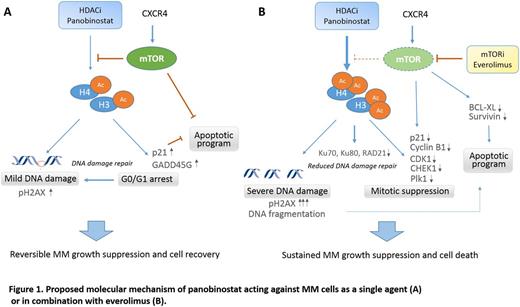Abstract
Introduction: Multiple myeloma (MM) is a neoplastic disorder that is characterized by clonal proliferation of plasma cells in the bone marrow (BM). Despite the initial efficacious treatment, MM patients often become refractory to common anti-MM drugs, therefore novel therapies are in need. Pan-histone deacetylase (HDAC) inhibitor panobinostat exerts multiple cytotoxic actions in MM cells in vitro, and was approved for the treatment of relapsed/refractory MM in combination with bortezomib and dexamethasone. Although having promising anti-MM properties, panobinostat lacks therapeutic activity as monotherapy. The aim of the current study was to elucidate the mechanisms underlying MM resistance to panobinostat and to define strategies to overcome it.
Results: Panobinostat at the low concentrations (IC50 5-30 nM) suppressed the viability in MM cell lines (n=7) and primary CD138+ cells from MM patients (n=8) in vitro. Sensitivity to panobinostat correlated with reduced expression of chemokine receptor CXCR4, while overexpression of CXCR4 or its ligand CXCL12 in RPMI8226 and CAG MM cell lines significantly (p<0.001) increased their resistance to panobinostat, pointing to the role of the CXCR4 axis in HDACi response. Notably, similar expression levels of class I HDACs (HDAC1-3) were detected in MM cells with either low or high CXCR4. Interaction with BM stromal cells that represent the source of CXCL12 also protected MM cells from panobinostat-induced apoptosis, further strengthening a role for CXCR4 downstream pathway. Decreased sensitivity to cytotoxic effect was concomitant with reduced histone (H3K9 and H4K8) acetylation in response to panobinostat treatment. In addition, resistance to HDACi was associated with the reversible G0/G1 cell growth arrest, whereas sensitivity was characterized by apoptotic cell death. Analysis of intra-cellular signaling mediators involved in CXCR4-mediated HDACi resistance revealed the pro-survival AKT/mTOR pathway to be regulated by both CXCR4 over-expression and interaction with BMSCs. Combining panobinostat with mTOR inhibitor everolimus abrogated the resistance and induced synergistic cell death of MM cell lines and primary MM cells, but not of normal mononuclear cells (CI<0.4). This effect was concurrent with the increase in DNA double strand breaks, histone H2AX phosphorylation, loss of Dψm, cytochrome c release, caspase 3 activation and PARP cleavage. The increase in DNA damage upon combinational treatment was not secondary to the apoptotic DNA fragmentation, as it occurred similarly when apoptosis onset was blocked by caspase inhibitor z-VAD-fmk. Kinetics studies also confirmed that panobinostat-induced DNA damage preceded apoptosis induction. Strikingly, combined panobinostat/everolimus treatment resulted in sustained DNA damage and irreversible suppression of MM cell proliferation accompanied by robust apoptosis, in contrast to the modest effects induced by single agent. Gene expression analysis revealed distinct genetic profiles of single versus combined exposures. Whereas panobinostat increased the expression of cell cycle inhibitors GADD45G and p21, co-treatment with everolimus abrogated the increase in p21 and synergistically downregulated DNA repair genes, including RAD21, Ku70, Ku80 and DNA-PKcs. Furthermore, combined treatment markedly decreased both mRNA and protein expression of anti-apoptotic factors survivin and BCL-XL, checkpoint regulator CHK1, and G2/M-specific factors PLK1, CDK1 and cyclin B1, therefore suppressing the DNA damage repair and inhibiting mitotic progression. Given the anti-apoptotic role of p21, the synergistic lethal effect of everolimus could be attributed to its ability to suppress p21 induction by panobinostat ensuing the shift in the DNA damage response toward apoptosis.
Conclusions: Collectively, our findings indicate that CXCR4/CXCL12 activity promotes the resistance of MM cells to HDACi with panobinostat through mTOR activation. Inhibition of mTOR by everolimus synergizes with panobinostat by simultaneous suppression of p21, G2/M mitotic factors and DNA repair machinery, rendering MM cells incapable of repairing accumulated DNA damage and promoting their apoptosis.
Our results unravel the mechanism responsible for strong synergistic anti-MM activity of dual HDAC and mTOR inhibition and provide the rationale for a novel therapeutic strategy to eradicate MM.
No relevant conflicts of interest to declare.
Author notes
Asterisk with author names denotes non-ASH members.


